Chen Ning Yang
Chen Ning Yang (Chinese杨振宁/杨振宁, Pinyin Yáng Zhenning; born September 22, 1922 in Hefei, China) is a Chinese- American physicist and Nobel laureate.
Life
Chen Ning Yang, who is also known as Frank or Franklin, was born on September 22, 1922 in Hefei, the first of five children of the mathematics professor Ke Chuan Yang and his wife Meng Hwa Loh Yang. He grew up on the campus of Tsinghua University in Beijing and studied at the University of Kunming, where he in 1942 his B.Sc. acquired with a thesis on group theory and molecular spectra. The M.Sc. he acquired in 1944 at Tsinghua University, which was also located during the Sino- Japanese War in Kunming. After the war he received from Tsinghua University in an America scholarship in January 1946 and went to the University of Chicago, where Enrico Fermi had a great influence on him. After receiving his doctorate in 1948 on the angular distribution of nuclear reactions and coincidence measurements with Edward Teller, he remained for a year as an instructor in Chicago before he transferred to the Institute for Advanced Study in Princeton (New Jersey), where he was in 1955 appointed professor. In 1965 he went to Stony Brook, where he spent the remainder of his career and remained even after his retirement.
Yang married Chih Li Tu in 1950 and the couple have three children, Franklin ( born 1951 ), Gilbert ( b. 1958 ) and Eulee (* 1961).
Work
Yang dealt mainly with statistical mechanics and symmetry principles. From him and Lee comes to predict the possibility of parity violation in the weak interaction, which was then confirmed experimentally by Wu. With Tsung- Dao Lee, with whom he worked for many years and published, but with whom he fell out later, he made many other contributions to the theory of elementary particles in the 1950s. The Yang-Mills theory (non abelian gauge theory ), was formulated by him and Robert L. Mills. With her now all the fundamental interactions of the Standard Model of physics are described, except gravity (but which can be described as a gauge theory ). At that time, the theory was, however, as mathematically elegant, but exotic and has been studied mainly as a toy model, for example as a model of quantization of gravity (eg Richard Feynman ). In the 1950s he studied with Lee the Ising model, an exactly solvable model of statistical mechanics.
Yang was awarded in 1957, together with Tsung- Dao Lee received the Nobel Prize in Physics " for fundamental research on the laws of parity, which led to important discoveries about elementary particles ".
Writings
- Elementary particles. From the discovery of the electron until the fall of parity, de Gruyter, 1972 ( German translation of Elementary Particles, Princeton University Press, 1961)
- Selected Papers 1945-1980, with commentary, Freeman 1983, World Scientific 2005
Selected essays:
- The spontaneous magnetization of a two dimensional Ising model, Physical Review, Volume 85, 1952, p 808
- With TD Lee Statistical theory of equations of state and phase transitions, Part 1.2, Physical Review, Volume 87, 1952, pp. 404, 410 (Yang -Lee zeros )
- With Robert Mills Isotopic spin conservation and a generalized gauge invariance, Physical Review, Volume 95, 1954, p 631 ( Yang-Mills theory )
- With Kerson Huang quantum mechanical many body problem with hard sphere interaction, Physical Review, Volume 105, 1957, p 776
- With Lee Many body Problem in quantum mechanics and quantum statistical mechanics, Physical Review, Volume 105, 1957, S.1119
- Lee: Question of parity conservation in the weak interactions, Physical Review, Volume 104, 1956, p 254 ( parity violation )
- With Lee parity non conservation and a two component theory of the neutrino, Physical Review, Volume 105, 1957, pp. 1671
- With Lee Implications of the intermediate boson basis of the weak interactions, Physical Review, Volume 119, 1960, pp. 1410
- The law of parity conservation and other symmetry laws of physics, Nobel Lecture 1957
- Nina Byers Theoretical considerations Concerning quantized magnetic flux in superconducting cylinders, Physical Review Letters, Volume 7, 1961, pp. 46
- Some exact results of the many body problem- in one dimension with repulsive delta function interaction, Physical Review Letters, Volume 19, 1967, p 1312 (Yang - Baxter relations)
- Tai Tsun Wu Concept of non integrable phase factors and global formula tion of gauge fields, Physical Review D, Volume 12, 1975, p 3845
- Magnetic monopoles, fiber bundles and gauge theories, Annals New York Academy of Sciences, Volume 294, 1977, p 86-97
- Interview with Zhang in Mathematical Intelligencer in 1994, No.4
- Einstein's impact on theoretical physics, Physics Today, June 1980










